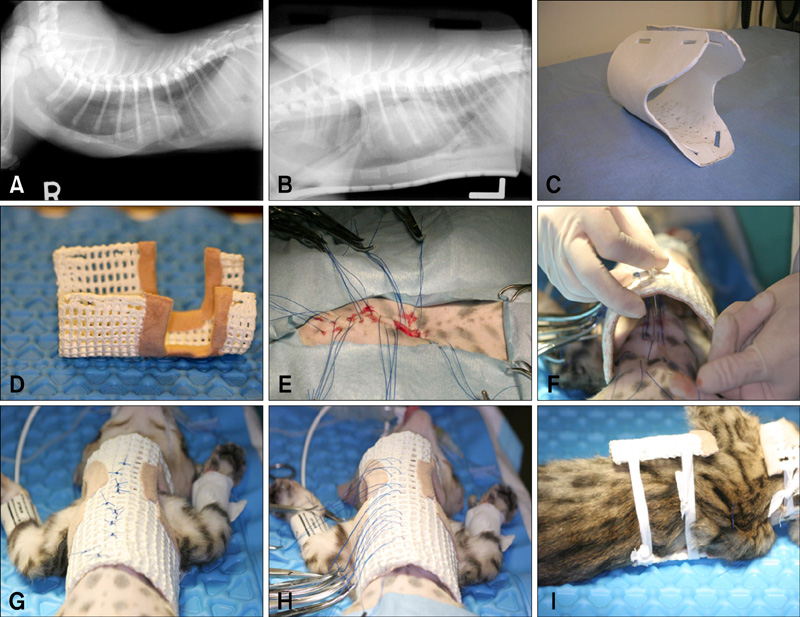J Vet Sci.
2008 Sep;9(3):335-337. 10.4142/jvs.2008.9.3.335.
Surgical correction of pectus excavatum in two cats
- Affiliations
-
- 1Department of Veterinary Medicine and Surgery, College of Veterinary Medicine, University of Missouri-Columbia, Columbia, MO 65211, USA.
- 2Department of Veterinary Surgery, College of Veterinary Medicine, Konkuk University, Seoul 143-701, Korea. swjeong@konkuk.ac.kr
- KMID: 1718589
- DOI: http://doi.org/10.4142/jvs.2008.9.3.335
Abstract
- Two sexually intact male Bengal cats, one a 4-month-old weighing 2.8 kg and the other, a 3-month-old weighing 2.0 kg, were presented to the University of Missouri-Columbia Veterinary Teaching Hospital for evaluation of respiratory distress. On initial presentation, both cats were dyspneic, exercise intolerant, and had marked concave deformation of the caudal sternum. Surgical correction of pectus excavatum was performed using a cylindrical external splint and U-shaped xternal splint. Post-operative thoracic radiography revealed that there was decreased concavity of the sternum and increased thoracic height at the level of the caudal sternebrae in both cats.
Keyword
MeSH Terms
Figure
Reference
-
1. Crigel MH, Moissonnier P. Pectus excavatum surgically repaired using sternum realignment and splint techniques in a young cat. J Sm Anim Pract. 2005. 46:352–356.
Article2. Fossum TW, Boudrieau RJ, Hobson HP. Pectus excavatum in eight dogs and six cats. J Am Anim Hosp Assoc. 1989. 25:595–605.3. Fossum TW. Pectus excavatum. Small Animal Surgery. 2007. 3rd ed. St. Louis: Mosby;889–894.4. Fossum TW, Boudrieau RJ, Hobson HP, Rudy RL. Surgical correction of pectus excavatum, using external splintage in two dogs and a cat. J Am Vet Med Assoc. 1989. 195:91–97.5. McAnulty JF, Harvey CE. Repair of pectus excavatum by percutaneous suturing and temporary external coaptation in a kitten. J Am Vet Med Assoc. 1989. 194:1065–1067.6. Risselada M, de Rooster H, Liuti T, Polis I, van Bree H. Use of internal splinting to realign a noncompliant sternum in a cat with pectus excavatum. J Am Vet Med Assoc. 2006. 228:1047–1052.
Article7. Soderstrom MJ, Gilson SD, Gulbas N. Fatal reexpansion pulmonary edema in a kitten following surgical correction of pectus excavatum. J Am Anim Hosp Assoc. 1995. 31:133–136.
Article
- Full Text Links
- Actions
-
Cited
- CITED
-
- Close
- Share
- Similar articles
-
- Surgical versus Vacuum Bell Therapy for the Correction of Pectus Excavatum: A Comparison of 1-Year Treatment Outcomes
- Silastic Molding Method for Pectus Excavatum Correction Using a Polyvinyl Alcohol (Ivalon) Sponge
- Surgical Treatment of Pectus Excavatum
- Repair of Recurrent Pectus Excavatum with a Huge Chest Wall Defect in a Patient with a Previous Ravitch and Pectus Bar Repair: A Case Report
- Simultaneous Nuss Operation and Mammoplasty in an Adult Patient with Pectus Excavatum: A case report


